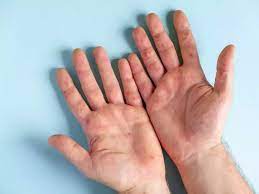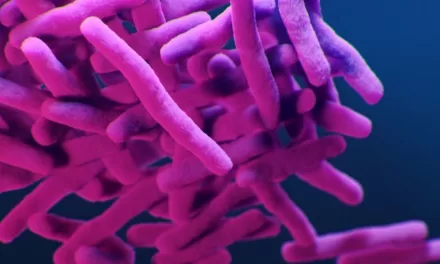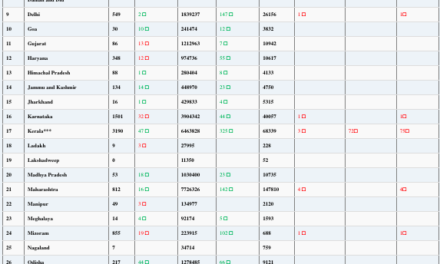Advisory on Hand Foot and Mouth Disease (HFMD), commonly known as “Tomato Flu” New Delhi, 23rd August, 2022
National Centre for Disease Control GOI

Occurrence in India:
Tomato Flu was first identified in the Kollam district of Kerala on May 6, 2022, and as of July 26, 2022, more than 82 children younger than 5 years with the infection have been reported by the local government hospitals. The other affected areas of Kerala are Anchal, Aryankavu, and Neduvathur. This endemic viral illness triggered an alert to the neighboring states of Tamil Nadu and Karnataka. Additionally, 26 children (aged 1–9 years) have been reported as having the disease in Odisha by the Regional Medical Research Centre in Bhubaneswar. To date, apart from Kerala, Tamil Nadu, Haryana and Odisha, no other regions in India have reported the disease in their State/UT by the virus.
Symptoms among children:
Tomato Flu is a viral disease. The name “Tomato Flu” comes from the main symptom of this disease, the tomato-shaped blisters on several body parts. The blisters start as red-colored small blisters and resemble tomatoes when they enlarge. Primary symptoms observed in children with Tomato Flu are similar to those of other viral infections, which include fever, rashes and pain in joints. Rashes on the skin can also lead to skin irritation. As with other viral infections, symptoms also include fatigue, nausea, vomiting, diarrhea, fever, dehydration, swelling of joints, body aches, and common influenza-like symptoms. HFMD is characterized by fever, sores in the mouth, and a skin rash. It begins with mild fever, poor appetite, malaise, and often a sore throat. One or two days after the fever begins, small red spots appear which changes to blister and then to ulcers. The sores are usually located on the tongue, gums, inside of the cheeks, palms and soles. In children with these symptoms, molecular and serological tests are done for diagnosis of dengue, chikungunya, zika virus, varicella-zoster virus, and herpes; once these viral infections are ruled out, a diagnosis of tomato flu is considered.
Tomato Flu is a self-limiting infectious disease as the signs and symptoms resolve after a few days. It seems the disease is a clinical variant of the so-called hand-foot-mouth disease that is common in school-going children. Infants and young children are also prone to this infection through the use of nappies, touching unclean surfaces as well as putting things directly into the mouth. HFMD occurs mainly in children under 10 years of age, but it can occur in adults too. There are no disease-specific medications available. Treatment is similar to other viral infections i.e. isolation, rest, plenty of fluids and a hot water sponge for relief of irritation and rashes. Supportive therapy of paracetamol for fever and body ache and other symptomatic treatments are required. Isolation should be followed for 5–7 days from the onset of any symptom to prevent the spread of infection to other children or adults.
Prevention:
The best solution for prevention is the maintenance of proper hygiene and sanitization of the surrounding necessities and environment as well as preventing the infected child from sharing toys, clothes, food, or other items with other non-infected children.
Following are some preventive measures we should keep in mind:
● Avoid immediate contact with the infected person
● Educate your child about the signs and symptoms and its side effects
● Tell your child not to hug or touch children having fever or rash symptoms
● You should encourage your children about hygiene maintenance and stopping thumb or finger sucking habits
● Encourage the child to use a handkerchief in case of running nose or coughing to avoid the spread of the disease
● Don’t scratch or rub the blister and wash every time you touch these blister
● Try to keep hydrated your child by motivating them to drink plenty of water, milk, or juice, whatever they prefer
● If your child develops symptoms of tomato fever, immediately isolate them from other children to inhibit disease progression.
● All utensils, clothes, and other utility items (for e.g. bedding) should be separated and sanitized regularly.
● Always use warm water to clean skin or for bathing the child
● Take a nutrition-rich, balanced diet to boost immunity
● It is essential to get enough rest and sleep to promote healing
As yet, no antiviral drugs or vaccines are available for the treatment or prevention of tomato flu. Further follow-up and monitoring for serious outcomes and sequelae are needed to better understand the need for potential treatments.
Laboratory Diagnosis:
Hand Foot and Mouth Disease (HFMD) is one of the many infections that result in mouth sores. However, health care providers can usually tell the difference between HFMD and other causes of mouth sores by considering the patient’s age, the symptoms reported by the patient or parent, and the appearance of the rash and/or sores. Diagnosis is largely clinical. Samples from throat or stool may be sent to a laboratory to test for isolating the virus involved in causing the illness, which may take 2–4 weeks to obtain the laboratory results. The testing should be done for investigation of an outbreak, so that preventive measures can be initiated.
Sample collection:
1. Respiratory Samples : Throat and / or Nasopharyngeal Samples can be collected within 48 hours of illness
2. Fecal Samples: The sample should be collected within 48 hours of illness
3. CSF: It can also be collected within 48 hours if patient has encephalitis
4. Biopsy of Lesions
5. Skin Scraping of lesions in Viral Transport Media: Rash with vesicles (From Palm of Hands/ Soles of Feet)
Laboratory Investigations:
1. Real-Time PCR
2. Viral isolation on a monolayer of Vero Rhabdomyosarcoma and MRC 5: If a cytopathic effect is seen, Immunofluorescence test with Enterovirus screening set (Panenterovirus, CBV, Echo, Poliovirus blends) may be done for confirmation
3. For Serology: the 4-fold rise in the level of neutralizing antibody in paired blood sample collected at an interval of 14 days (One Acute sample at the onset of illness and second sample after ten days of illness)
Storage:
Transportation Sample should be transported to the laboratory on ice for virus isolation/serology within 24 hours. In case of Delay, it may be stored at -20o C for 2-3 days and sent on ice to the laboratory at the earliest.
Summary:
Although the Tomato Flu virus shows symptoms similar to other viral infections (fever, fatigue, body aches and rashes on the skin); the virus is not at all related to SARS-CoV-2, monkeypox, dengue and/or chikungunya. In fact, recent reports have suggested it to be Coxsackie A 17 that belongs to the group of enteroviruses.
The disease will best be described as a clinical variant of the viral hand, foot, and mouth disease, a common infectious disease targeting mostly young children aged 1–10 years and immune-compromised adults, and sometimes exposed to immune-competent adults.
Tomato flu is a self-limiting illness and no specific drug exists to treat it. Note: These guidelines are subject to modification as and when further literature or information is obtained at the institute.










